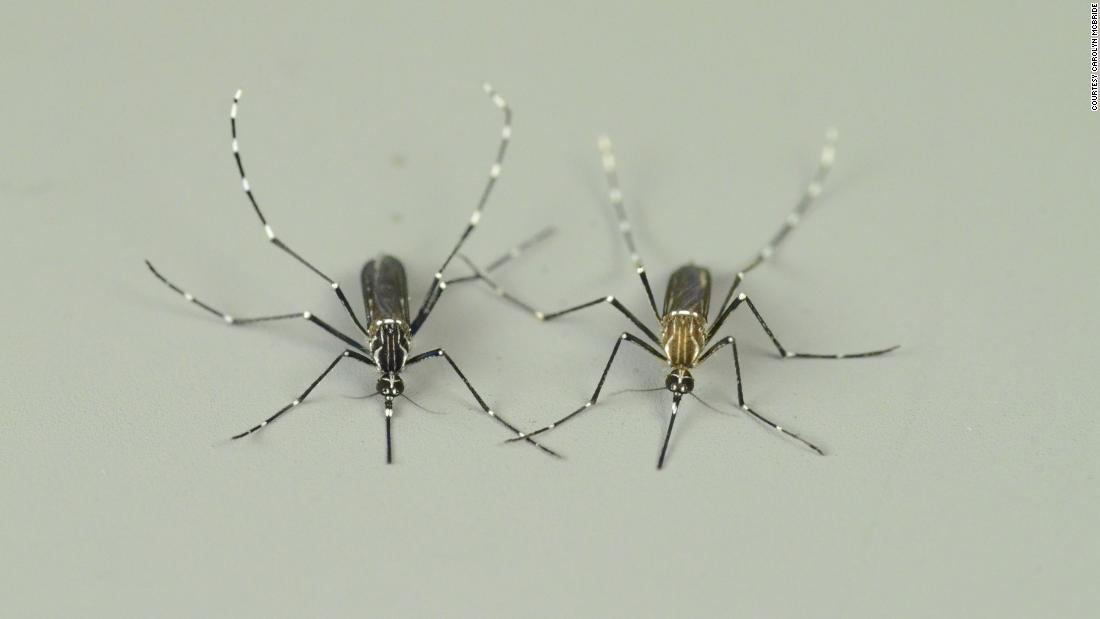It is currently unknown how mosquitoes that bite humans track us so effectively, but it is important, as they not only make us itch. They also carry dangerous diseases like Zika, dengue, West Nile virus and malaria, which can be fatal.
In fact, stopping these annoying insects in their tracks could save up to half a million lives lost to these diseases each year.
“In each case where a mosquito evolved to bite humans – which has only happened two or three times – they become vectors for unpleasant diseases,” said Carolyn “Lindy” McBride, assistant professor of ecology and evolutionary biology at Princeton University Neuroscience Institute in New Jersey.
That’s why she wants to understand how they find and target humans.
Mosquitoes can smell us
“Mosquitoes mainly choose what to bite based on odor,” said McBride, whose laboratory focuses on Aedes aegypti mosquito species that have evolved to bite humans specifically.
Only female mosquitoes suck blood, as they need it to produce their eggs. Knowing how a potentially disease-transmitting mosquito female sniffs a person, while ignoring other warm-blooded animals, is a key issue.
Once this is better known, much more effective repellents – or baits to lure mosquitoes away from humans – could be made, saving lives, said Christopher Potter, associate professor of neuroscience at the Center for Sensory Biology at Johns Hopkins University.
If scientists can control their sense of smell, “we can really control what these mosquitoes are doing,” said Potter, who studies another mosquito specific to humans, the Anopheles, which transmits malaria.
Our odors are complicated
It is not an easy question to answer, since any animal smell is made up of hundreds of chemical compounds mixed in specific proportions.
Each time a hungry female mosquito flies by, it is doing complex chemical math in its tiny brain, discovering what is a human, what is a dog and what is a flower.
A library of smells
The McBride lab team created a library of the chemical composition of animal odors. “That data set doesn’t really exist – so we decided to go out and collect it ourselves,” said Jessica Zung, a graduate student in McBride’s lab.
Zung has collected odor samples from about 40 different animals so far, including guinea pigs, mice, quails and more.
A common compound stood out
Comparing some of these to the 16 human samples, something jumped out. Decanal, a simple and common compound, is particularly abundant in human skin, said Zung.
Understanding what mosquitoes are sniffing is only part of the story; knowing how they do it is also important. To see exactly how mosquitoes use this sense, scientists created genetically engineered Aedes aegypti mosquitoes “so that we could open their heads and place them under a sophisticated microscope and actually watch neurons fire when exposed to human and animal odors,” said McBride.
The research team already knew that mosquitoes have about 60 different types of neurons that smell, so when they looked at the insects’ brains, they thought they could see a lot of activity. But it was surprisingly quiet, which means that the signal was perhaps quite simple, reduced to just a few types of neurons.
This type of research was only possible after the technology to study the mosquitoes’ brain in detail became available, which has only happened recently. “It is traditionally very difficult to study this at the level we are doing now,” said Potter.
An example of rapid evolution
Incredibly, mosquitoes that target humans have evolved to be able to do that only in the last 5,000 years, so it’s a “really incredible example of rapid evolution,” said McBride.
Aedes aegypti, also known as the “yellow fever mosquito”, is also a carrier of dengue, zika and chikungunya. The creature originated in Africa and probably reached its current reach in the southern United States and Central and South America on slave ships during the 1600s, according to McBride.
Keeping them away is simple
As for internal knowledge about how to avoid being bitten in your own backyard, McBride said he uses a fan.
“Make it blow where you are sitting outside or on the barbecue or under the table where they are biting your feet.” It’s not that you’re spreading the scent to get mosquitoes out of the way, she said.
It is simply because these deadly creatures, said McBride, “are not great flyers”.
A former geologist, Starre Vartan is a science journalist and dog runner who lives on an island in Puget Sound, near Seattle, and still picks up rocks wherever he goes.
